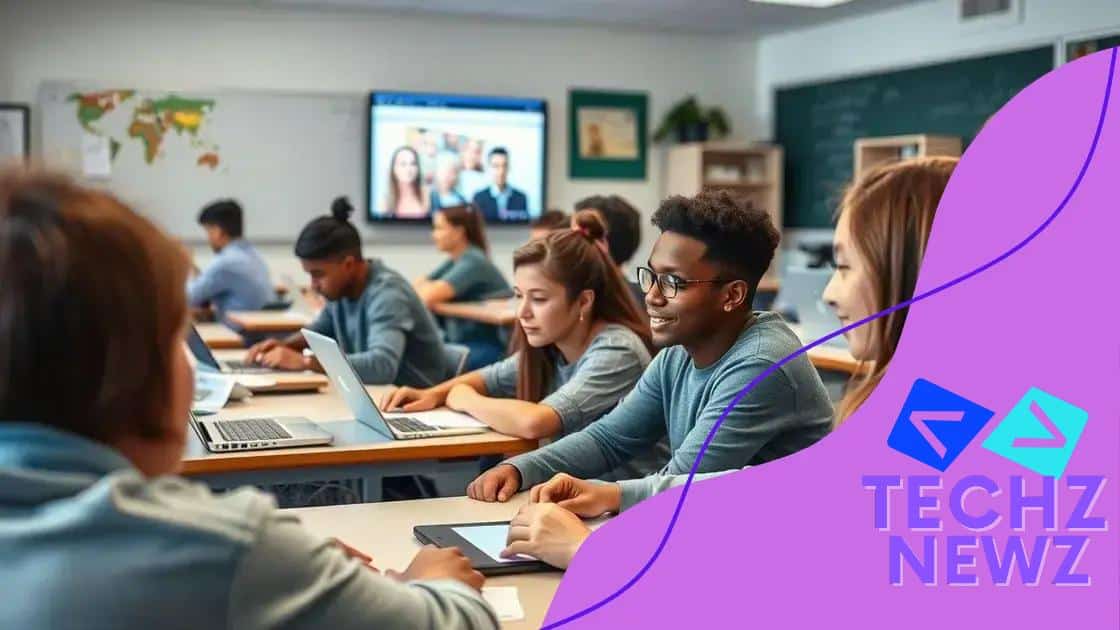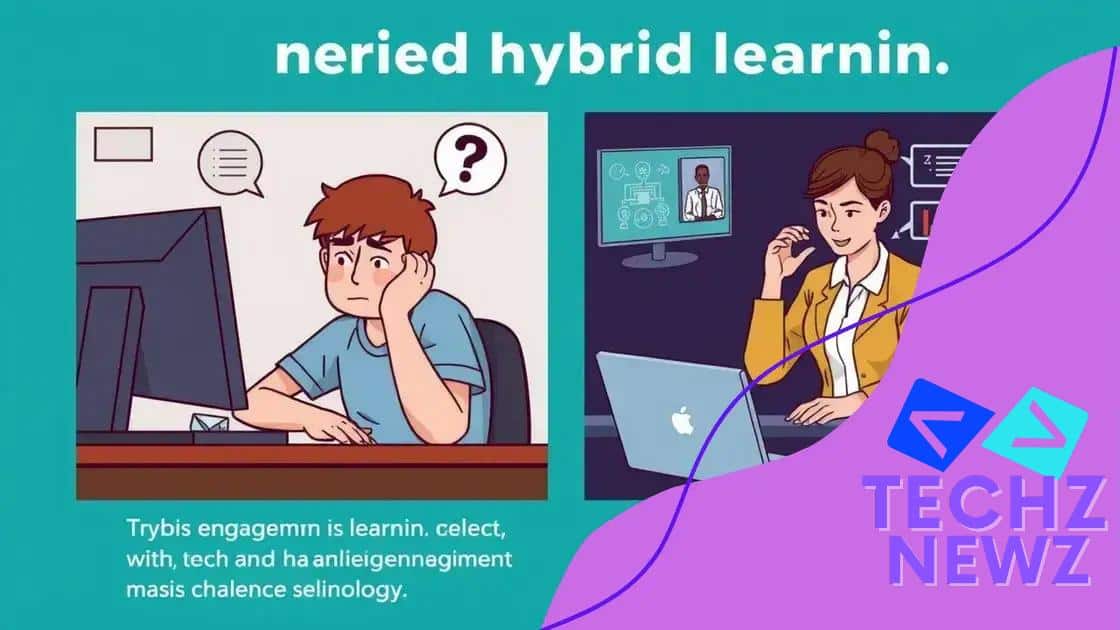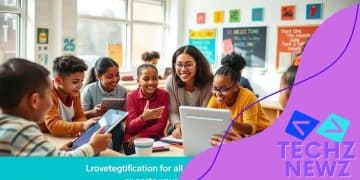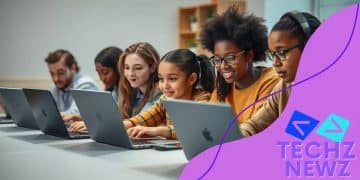Hybrid learning systems post-pandemic in universities

Hybrid learning systems in universities combine in-person and online education, enhancing flexibility, engagement, and accessibility, while addressing challenges like technology barriers and ensuring equity among students.
Hybrid learning systems post-pandemic in universities are reshaping how education is delivered. With the shift in learning methods, students and educators alike are navigating a new landscape that blends traditional and digital approaches. Have you wondered how this impacts your learning experience?
Understanding hybrid learning systems
Understanding hybrid learning systems is essential for modern education. These systems combine traditional face-to-face instruction with online learning components, offering flexibility.
The Basics of Hybrid Learning
Hybrid learning systems allow students to learn at their own pace while still benefiting from direct interaction with instructors.
Key Characteristics
- Flexibility in choosing learning environments.
- Access to a broader range of resources.
- Encourages student engagement and participation.
With the rise of technology, many educational institutions have adopted hybrid models to adapt to students’ diverse needs. Students can attend classes physically or engage with content online, making learning more accessible. This adaptability is particularly important in our evolving educational landscape.
Moreover, hybrid learning systems provide opportunities for collaborative projects where students can work together, regardless of their physical location. As classrooms become increasingly digital, tools and platforms are improving how students interact and learn.
Benefits of Hybrid Learning
Hybrid learning presents numerous benefits that enhance the educational experience:
- Personalized learning paths for each student.
- Improved retention through a mix of learning styles.
- Facilitates continuous learning, even during disruptions.
In summary, understanding hybrid learning systems is crucial for adapting to today’s educational needs. They offer unique opportunities for growth and development, ensuring students receive a comprehensive education that suits their learning preferences.
Advantages of hybrid models in universities
The advantages of hybrid models in universities are significant and diverse. By merging traditional classroom experiences with online learning, these models offer unique benefits for both students and educators.
Enhanced Flexibility
One major advantage is the flexibility it provides. Students can attend lectures in person while also having the option to access course materials online.
Improved Accessibility
This model also fosters accessibility. Students from various locations can engage in the same course, breaking down geographical barriers. Those with disabilities or other commitments can better manage their time and resources.
- Access to a wider range of courses.
- Ability to participate at one’s own pace.
- Support for diverse learning styles.
Additionally, hybrid learning systems encourage student engagement. With interactive online platforms, educators can incorporate diverse teaching methods that cater to different learning preferences, promoting a richer educational experience. This results in better retention of information as students can connect with content in multiple ways.
Administrative efficiency improves as well. Universities can reduce operational costs by utilizing space effectively and minimizing the need for physical resources.
Developing Self-Direction
Another advantage is that hybrid models cultivate self-directed learning skills. Students learn to take initiative and responsibility for their education, ultimately preparing them for future careers.
- Encourages critical thinking and problem solving.
- Improves time management skills.
- Helps students become more autonomous.
In summary, the advantages of hybrid learning models in universities are profound. They create a well-rounded educational environment that is flexible, accessible, and conducive to student success.
Challenges faced with hybrid learning post-pandemic

The challenges faced with hybrid learning post-pandemic are numerous and significant. As universities adapt to this new learning model, various obstacles emerge that need to be addressed.
Technological Barriers
One of the primary challenges is the need for reliable technology. Students and instructors require access to devices and stable internet connections. Without these, the effectiveness of hybrid learning diminishes greatly.
Student Engagement
Maintaining student engagement can also be difficult in a hybrid model. Students participating remotely may feel disconnected from their peers and instructors, leading to lower participation rates. Creating an environment where all students feel included is paramount.
- Strategies to enhance engagement are vital.
- Facilitate group activities and discussions online.
- Utilize interactive tools to keep students involved.
Moreover, some instructors may struggle to transition to this new teaching style. Training is essential for faculty members to effectively utilize hybrid systems. They need to be comfortable with technology and engage students in both settings effectively.
Equity Issues
Equity also poses a challenge, as not all students have the same access to resources. This disparity can create gaps in learning experiences, leading to unequal outcomes. Universities must devise plans to support all students, ensuring everyone has the opportunity to succeed.
- Providing resources for those in need is crucial.
- Adopting inclusive practices in teaching.
- Addressing mental health issues that may arise.
Lastly, evaluating the effectiveness of hybrid learning remains a challenge. Institutions must continually assess their strategies and adapt based on feedback to ensure the delivery of quality education.
Real-life examples of effective hybrid learning
Real-life examples of effective hybrid learning offer valuable insights into how this educational model can work. Many universities have successfully implemented hybrid approaches that enhance student engagement and learning outcomes.
Case Study: University of Southern California
The University of Southern California (USC) adopted a hybrid model that blends in-person and online classes. In this system, students engage with digital content before attending classes, which allows them to come prepared. This method has shown improved participation and understanding.
Interactive Learning at the University of Colorado
At the University of Colorado, hybrid learning incorporates interactive tools such as live polls and discussion boards during lectures. This approach encourages student involvement and allows professors to gauge understanding in real time. Students appreciate the ability to ask questions and interact quickly from their own devices.
- Combining technology with teaching enhances learning.
- Immediate feedback helps students clarify doubts.
- Students feel more engaged through active participation.
Additionally, the University of Minnesota started using hybrid techniques for its healthcare courses. By allowing students to attend simulations in person while accessing lectures online, they successfully prepare future healthcare professionals for real-world scenarios while accommodating diverse learning styles.
Collaboration at Arizona State University
Arizona State University (ASU) has developed a robust hybrid model emphasizing collaboration. Students often work in teams both in person and online, fostering a richer learning experience. They utilize video conferencing tools to collaborate on projects, ensuring that all students, regardless of location, can contribute.
- Group projects enhance teamwork skills.
- Flexibility in group formation allows for diverse perspectives.
- Encourages communication skills among peers.
These real-life examples demonstrate the potential of hybrid learning to create engaging, effective learning environments. By integrating technology with traditional methods, universities provide students with the necessary tools to succeed.
Future trends in hybrid education systems
The future trends in hybrid education systems are shaping a new landscape for learning. As technology advances, these systems will evolve to better meet the needs of students and educators alike.
Increased Use of AI
One significant trend is the increased integration of artificial intelligence in educational platforms. AI can help personalize learning experiences by analyzing student performance and suggesting tailored content. This allows for more individualized attention and support.
Greater Collaboration Tools
As hybrid learning continues to grow, expect more sophisticated collaboration tools. Platforms will enable seamless communication among students and teachers, regardless of their location. Workshops, group projects, and interactive sessions will become more dynamic and engaging.
- Real-time collaboration across various devices.
- Enhanced virtual classroom experiences.
- Tools that facilitate brainstorming and sharing ideas effectively.
Moreover, online learning communities will gain popularity. These communities provide support and foster connections among students, making learning a shared experience. Through forums and collaborative projects, students can share resources and insights, enriching their educational journey.
Focus on Lifelong Learning
Another trend is the emphasis on lifelong learning. As job markets change, continuous education becomes crucial. Hybrid systems will provide accessible options for professionals seeking to upskill or reskill without disrupting their careers.
- Flexible course offerings that accommodate busy schedules.
- Affordable access to expert-led training.
- Integration of real-world applications into learning.
Additionally, universities will emphasize the importance of mental health and well-being in hybrid education. As students navigate online and offline education, institutions will incorporate resources and support systems to promote a healthy balance.
In conclusion, hybrid education systems are transforming the way we learn. By blending traditional and online learning, these models offer flexibility, accessibility, and engagement. As technology advances, tools like AI will enhance educational experiences, making learning more personalized. Universities are also prioritizing collaboration among students and lifelong learning opportunities. Despite the challenges, the future of hybrid learning looks promising, paving the way for a more inclusive and innovative education.
Here’s a summary of the key points related to the future of hybrid education systems:
FAQ – Frequently Asked Questions about Hybrid Learning Systems
What are hybrid learning systems?
Hybrid learning systems combine traditional in-person classroom experiences with online education, offering flexibility and accessibility for students.
How do hybrid learning systems benefit students?
These systems enhance student engagement by allowing personalized learning at their own pace and by incorporating technology.
What challenges do universities face with hybrid learning?
Universities must address technological barriers, student engagement issues, and ensuring equity among students to succeed in hybrid models.
What future trends can we expect in hybrid education?
Future trends include increased use of AI for personalized learning, more collaboration tools, a focus on lifelong learning, and enhanced mental health support.





